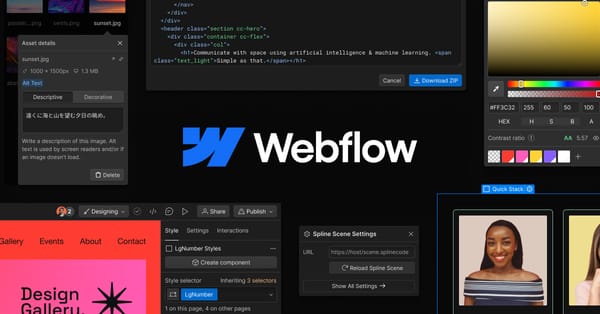Ah, Webflow.
The platform that's been a cornerstone for web designers and developers for the past decade.
It’s grown, it’s evolved, and now it’s rolling out some changes to its Site and Workspace plans. Let’s dive into what’s new, highlighting the positives while acknowledging a few points of contention.
The Good, the Bad, and the Bandwidth Limit
First off, Webflow is adding some genuinely useful features. A new usage dashboard, no limits on site visitors (for now), and increased custom code limits?
Yes, please.
Enhanced security with HSTS and the ability to convert CMS images into WebP files are also welcome improvements.But let's talk about the real elephant in the room: the updated plan limits. If you’re on the Starter or CMS Site plans, you’ll see some increases in fields and references per collection, which is great.
However, the massive slash in bandwidth—from 50GB to 10GB on the Basic Site plan and from 200GB to 50GB on the CMS Site plan—feels like a punch in the gut. Sure, they’re offering bandwidth add-ons, but who didn’t see that revenue stream coming?
Bandwidth Limits: A Not-So-Small Hiccup
Webflow knows this change might be hard to swallow, especially for agencies and freelancers. They’re giving us until early 2025 before they start enforcing bandwidth limits.
That’s a year and a half to figure out how to explain to clients why their once “unlimited” plan now has constraints.
And let’s not forget the “complimentary surge protection” for traffic spikes. A nice gesture, but one can’t help but wonder if it’s a solution to a problem they’ve created.
Webflow assures us that their goal is to grow with our businesses.
But they also plan to review and potentially adjust their pricing and service packages. With their goal to make offerings "more sustainable and suitable for long-term use, aiming to provide better value and support scalability as customers' needs grow".
This could lead to more competitive pricing, new pricing tiers, or bundling features in ways that better meet the demands of different users.
Simplified seats and roles sound promising, and they’re committed to improving pricing and packaging. We’re cautiously optimistic about these future enhancements. After all, Webflow has been a reliable partner in our web development journeys.
The Silver Lining
Despite the bandwidth drama, the new features and increased limits on collections are solid upgrades. For those who rely on Webflow for complex projects, these changes could streamline workflows and enhance site performance.
And if the future improvements to team management and pricing are as good as promised, we might find ourselves forgiving the bandwidth cuts. In conclusion, Webflow’s latest updates are a mixed bag.
There’s plenty to be excited about, but also some frustrations to navigate. Here’s hoping Webflow’s next set of changes tip the balance firmly into the positive.










